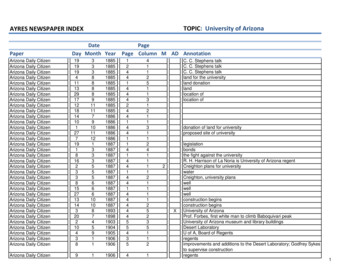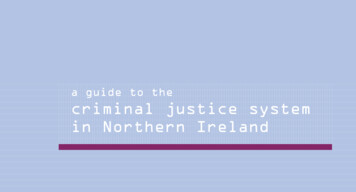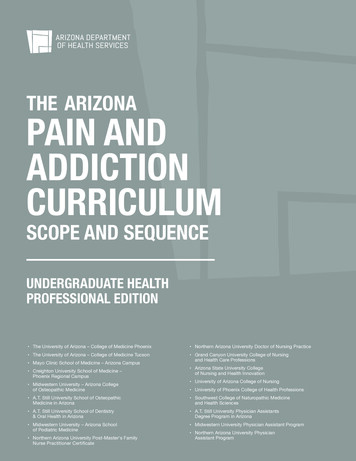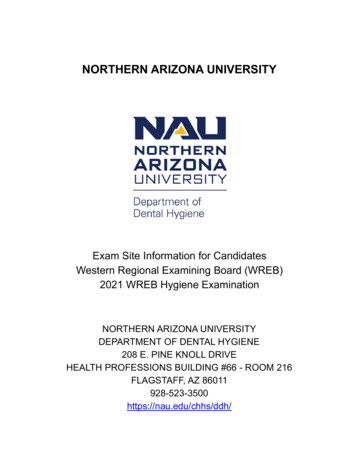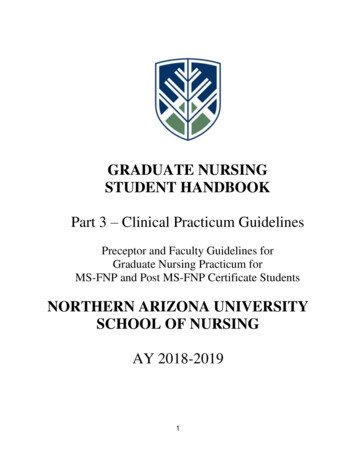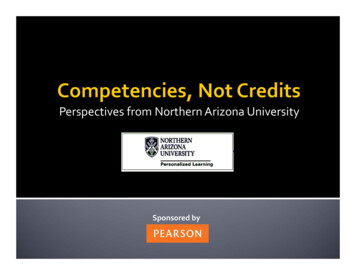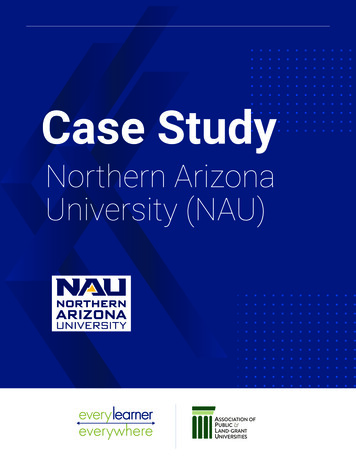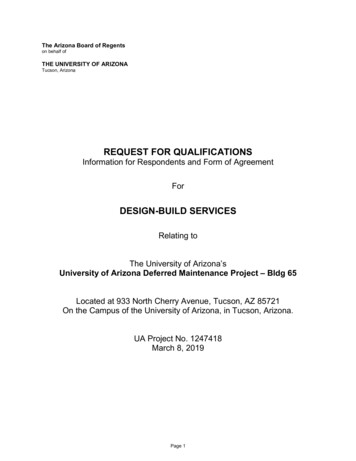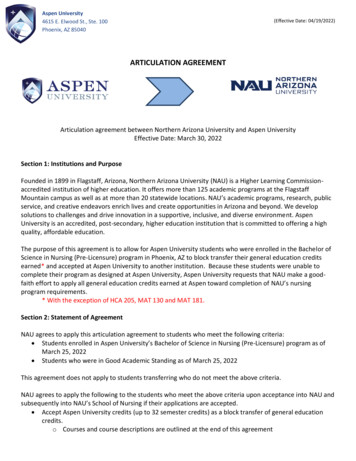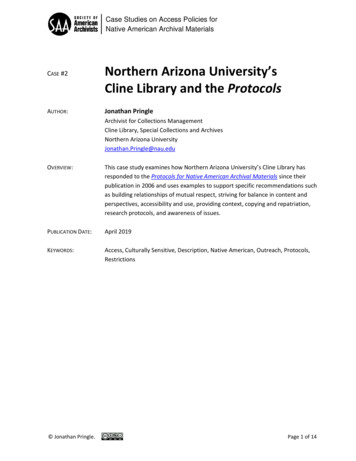
Transcription
Case Studies on Access Policies forNative American Archival MaterialsCASE #2AUTHOR:Northern Arizona University’sCline Library and the ProtocolsJonathan PringleArchivist for Collections ManagementCline Library, Special Collections and ArchivesNorthern Arizona UniversityJonathan.Pringle@nau.eduOVERVIEW:This case study examines how Northern Arizona University’s Cline Library hasresponded to the Protocols for Native American Archival Materials since theirpublication in 2006 and uses examples to support specific recommendations suchas building relationships of mutual respect, striving for balance in content andperspectives, accessibility and use, providing context, copying and repatriation,research protocols, and awareness of issues.PUBLICATION DATE:April 2019KEYWORDS:Access, Culturally Sensitive, Description, Native American, Outreach, Protocols,Restrictions Jonathan Pringle.Page 1 of 14
Introduction and Institutional ContextWhen discussing the Protocols for Native American Archival Materials, it would be difficult to do sowithout including their relationship to the institution in which they were originally drafted. NorthernArizona University’s Cline Library was integral in bringing together a team of international colleagues—nineteen Indigenous and non-Indigenous archivists, librarians, museum curators, historians, andanthropologists—to share ideas and collaborate on what would eventually become the Protocols. Theseauthors gathered in the Presidents’ Room of the library, a special space available to the universitypresident for various special events; it is aptly located within the footprint of the library’s SpecialCollections and Archives department. Since their publication in spring 2006, the Protocols have hadprofound impact on Cline Library, Northern Arizona University, and the profession in a regional, national,and international capacity.It has been thirteen years since their release, and the archival profession has spent much of this timedebating the Protocols and its place within contemporary archival theory and practice. While Cline Librarywas quick to embrace the guidelines articulated in the Protocols, archivists and librarians across thecountry took a much more cautious and skeptical approach. In late 2007, the Society of AmericanArchivists created a task force that surveyed archivists in the United States about the Protocols; theyreleased their findings publicly in February 2008.1 The report emphasized many trepidations thatarchivists felt about how the Protocols would impinge on core professional values concerning access andboth academic and intellectual freedoms. At the core of the feedback was a sense of discomfort with thelevel of engagement with source communities recommended in the Protocols, and how firmly heldunderstandings of intellectual and physical property rights were now being challenged. The Society ofAmerican Archivists’ (SAA) Native American Archives Roundtable, created in 2005, helped with theformation of the Native American Protocols Forum Working Group; they facilitated discussions at the2009, 2010, and 2011 SAA Annual Meetings.2 These sessions were designed as a way to present theProtocols to archival colleagues broadly and answer any questions asked by the SAA membership moredirectly. Despite ongoing and repeated concerns, a quiet revolution was already forming: the Protocolswere now being discussed and debated in the profession and the classroom. A new generation ofinformation professionals were becoming more engaged with issues of equality and social justice.Contemporaneously, institutions of all shapes and sizes shared with the Forum Working Group that theyhad begun implementing aspects of the guidelines in their own collaborative work with local Indigenouscommunities. It would not take long before SAA would confirm its commitments to issues of diversity andinclusion3 and see an evolution with its core values and ethics to support this.123Society of American Archivists, “Report: SAA Task Force to Review Protocols for Native American Archival Materials(February 2008),” 0208-NativeAmProtocols-IIIA.pdf.The Native American Protocols Forum Working Group released a full report on these meetings in 112-V-I-NativeAmProtocolsForum.pdf.Society of American Archivists, “Statement on Diversity and Inclusion,” revised August atement-on-diversity-and-inclusion.SAA Case Studies on Access Policies for Native American Archival MaterialsPage 2 of 14
The most recent Society of American Archivists endorsement of the Protocols as an external standard(August 2018) provides further validation of its continued acceptance and use. However, Cline Library hadbeen engaged with implementing aspects of the document well before then. Northern Arizona Universitywas one of the first national institutions to both endorse and adopt the Protocols, providing the librarywith significant leverage when determining effective and meaningful implementation strategies, includingbuilding upon any existing efforts. As such, Cline Library is uniquely positioned to help model how otherpublicly-funded state institutions of higher learning can interpret the “guidelines for action” contained inthe Protocols. As a precursor, it should be emphasized that Cline Library sees the Protocols as a series ofdescriptive guidelines, rather than prescriptive rules that must be followed. The authors recommendedthat “Institutions and communities are encouraged to adopt and adapt the culturally responsiverecommendations to suit local needs.”4 Every repository and Indigenous community is unique and willboth interpret and adopt the Protocols according to their own institutional goals or objectives. As will beshown throughout this case study, several guidelines have not been exercised at Cline Library; this maybe because they were not applicable within the library’s past or present operations, or perhaps because asituation requiring an intervention advised in the Protocols had not yet presented itself. For this reason,the Protocols functions most effectively as an invaluable reference tool for non-Indigenous repositoriesseeking to strengthen their connections with Indigenous communities represented in their holdings. Aseach section within the Protocols demonstrates, these collaborations cover a breadth of relatable topics.Ultimately, this case study examines how Cline Library has responded to the Protocols and uses examplesto support specific recommendations addressed throughout the document. It is hoped that other similarinstitutions, or even those with different funding structures (i.e., private, corporate) or that are located indifferent geographic locales, can find Cline Library’s experiences useful in their own interpretations andimplementations.Cline Library continues to thank the nineteen contributors5 who came to Flagstaff to draft this importantdocument; without them and their participation the profession would not be having these criticalconversations that help to move the rights of Indigenous peoples in a positive direction. Many of theseoriginal contributors continue to collaborate with Cline Library on issues of shared stewardship ofIndigenous resources. Special kudos must be made as well to Karen Underhill6, former Head of SpecialCollections and Archives at Cline Library. Underhill was instrumental in securing funding to bring thegroup together, ultimately realizing over a decade of personal and professional commitment to betterserving Cline Library and Northern Arizona University’s Indigenous communities, patrons, and colleagues.456First Archivists Circle, Protocols for Native American Archival Materials (Flagstaff: Northern Arizona University, 2006), 7.Kathryn “Jody” Beaulieu (Anishinabe/Ojibwe), Briana Bob (Colville Confederated Tribes), Sheree Bonaparte(Mohawk/Akwesasne), Steve Crum (Shoshone), Amelia Flores (Mohave), Alana Garwood-Houng (Yorta Yorta), DavidGeorge-Shongo (Seneca), Eunice Kahn (Diné), Stewart Koyiyumptewa (Hopi), Kim Lawson (Heiltsuk), Robert Leopold,Gloria Lomahaftewa (Hopi), James Nason (Comanche), Jennifer R. O’Neil (Confederated Tribes of GrandeRonde/Chinook), Lotsee Patterson (Comanche), Richard Pearce-Moses, Willow Roberts Powers, Alyce Sadongei(Kiowa/Tohono O’odham), Karen Underhill.For Underhill’s excellent description of the ten sections of the Protocols, see: Underhill, Karen J., “Protocols for NativeAmerican Archival Materials,” RBM: A Journal of Rare Books, Manuscripts, and Cultural Heritage 7:2 (2006), 134–145.Available from: 7.SAA Case Studies on Access Policies for Native American Archival MaterialsPage 3 of 14
Building Relationships of Mutual RespectCline Library has benefited from the broader institution’s commitment to serving Native American andIndigenous students, staff, and adjacent communities. In its most recent strategic plan7, Northern ArizonaUniversity has made “Commitment to Native Americans” its third out of five institutional goals,prioritizing it after “Student Success and Access” and “Research and Discovery.”8 Within this goal are fiveobjectives, one of which asks NAU to “Collaborate with Native/Indigenous nations to develop projectsand programs for the direct benefit of Native American and Indigenous communities,” while anotherseeks to “Promote appreciation and understanding of Native American/Indigenous people, cultures, andnations within the university and in the broader community.”9 These objectives dovetail with thefunctions of the campus’ Native American Cultural Center (NACC),10 which opened in 2011 and serves as afamilial space for the nearly 900 Native American and Indigenous students; these students representapproximately 3% of NAU’s total student population.11 Staff with NACC, in particular the NAU VicePresident of Native American Affairs, have done significant work with relationship-building among thetwenty-one federally recognized tribes12 and their representatives in Arizona. Cline Library hascollaborated with NACC on a number of occasions when materials in its possession relate to communitiesin which the library seeks updated or altogether new contacts with a tribe’s historic preservation office,library, archives, or community center. In some cases, Cline Library has longstanding relationships withspecific communities, and NACC staff have been receptive to coordinating efforts and sharing resources.Relationship-building involves labor on the part of the institution seeking collaborations with tribalcommunities. Rather than the community doing all of the work to discover resources pertaining to themin Cline Library collections, the library’s Special Collections and Archives (SCA) department has combedthrough many of its primary-source resources and has created a comprehensive LibGuide to “IndigenousPeoples in Special Collections and Archives.”13 This tool has the capacity to significantly increaseengagements with communities, and provides a checklist-like opportunity for consultation andcollaboration. By way of example, out of the 568 primary-source collections that comprise archivalholdings in SCA, 193 of them contain content that refer to the Navajo/Diné community. The LibGuide isorganized in a navigable series of subject tabs, which helps organize the 193 collections in a meaningfuland engaging manner for multiple audiences. While this approach is more proactive, ad-hoc consultationswith specific collections have also occurred, requiring the identification of an appropriate liaison with aspecific tribe depending on the contents of the materials. SCA’s digital archives,14 for example, generally7891011121314Northern Arizona University, 2018-2025 Strategic Plan: One NAU. Side by Side. https://nau.edu/strategic-plan-2025.Ibid.Northern Arizona University, “Goal 3: Commitment to Native Americans,” in 2018-2025 Strategic Plan: One NAU. Side bySide. native-americans/.“Native American Cultural Center,” Northern Arizona University, /.Naomi Bishop, Jonathan Pringle, and Carissa Tsosie, “Connecting Cline Library with Tribal Communities: A Case Study,” inCollection Management 42:3-4 (2017), 240–255. Available from http://openknowledge.nau.edu/5229/.“List of Federal and State Recognized Tribes,” National Conference of State d-tribes.aspx#az.“Indigenous Peoples in Special Collections and Archives,” https://libraryguides.nau.edu/c.php?g 759211.“Special Collections and Archives Digital Archives,” http://archive.library.nau.edu/cdm/search/.SAA Case Studies on Access Policies for Native American Archival MaterialsPage 4 of 14
contain materials pertinent to the US Southwest, however a recent accidental digitization of a series ofMenominee images from Wisconsin (well outside SCA’s geographic collecting scope) turned into anopportunity to engage with a community that would otherwise not have known these materials existed.15Transfers of records between institutions is a frequent and necessary occurrence, and one that can lenditself well to future collaborations and increased trust-building. Geographic scope is a strongconsideration when determining whether an archives’ holdings should be retained; in many cases archivalprofessionals find more suitable repositories for those materials that are felt be outside of its collectingscope. Yet simply retaining records due to their content being relevant within the geographic boundariesof the institution is not enough. In many cases, rights to materials can reside with other entities; inothers, a donor may not have even had the rights necessary to convey to an institution in the first place.Further still, a competing institution within the same geographic area may ultimately be more suitable forthe long-term care of the materials. Nowhere can this be more frequently seen than with the records ofanthropologists and archaeologists. The Southwest has been the focus of extensive archaeologicalexcavation and anthropological research. SCA houses the research files of a number of well-knownregional anthropologists. In some cases, the work they were doing was located directly on tribal land; inone instance, the tribe commissioned the work itself. Beginning in 2016, a significant deaccessioningproject was undertaken that saw a portion of the archaeological records of one such anthropologist, Dr.Robert Euler,16 returned to the respective land owner (tribal, state, or federal) or anotheragency/institution tasked with managing and maintaining the materials through any sort of existingcuration agreements. Outreach to a tribe’s historic preservation departments or their libraries, archives,or museums helped facilitate this positive opportunity to form new partnerships and further developexisting ones. To ensure the integrity of the materials and to help facilitate transparency, as physicalrecords were being deaccessioned, patrons were given details about where those records had been sentthrough the finding guide (figure 1).Relationship-building also similarly extends to establishing policies and agreements with Indigenouscommunities around collaboration. Collaboration is critical for institutions in possession of potentiallyharmful or culturally sensitive information in their repositories. Since the early 1990s, NAU has had aformal partnership with the Hopi Cultural Preservation Office and a series of reciprocal actions expressedthrough a formal memorandum of agreement (MOA).17 The most recent version of this MOA was signedbetween NAU President Dr. Rita Cheng and Hopi Tribal Chairman Herman G. Honanie in November 2016.The MOA with the Hopi Tribe is a commitment-based response that strikes many similar tones seen in151617A chance encounter with a Menominee woman at the 11th Annual International Conference of Indigenous Archives,Libraries, and Museums in Prior Lake, MN (October 2018) allowed this author to share a hyperlink for digital materials inSCA holdings related to the Menominee. This effort was designed to allow for future collaborative opportunities that wouldhelp facilitate the identification of sensitive materials or other mutually beneficial access efforts.“Robert C. Euler Finding Guide,” Arizona Archives cId ead/nau/euler robert.xml.Hopi Tribe and the Arizona Board of Regents [ABOR] Acting for and on Behalf of Northern Arizona University,Memorandum of Agreement (revised November 2016), internal document.SAA Case Studies on Access Policies for Native American Archival MaterialsPage 5 of 14
Figure 1. Deaccession Note in the Robert C. Euler Collection from Arizona Archives Online.the Protocols. For example, the Protocols asks that archives and libraries “Be cautious in approving accessor use requests, if the requests appear to conflict with the Protocols, until appropriate tribal communityrepresentatives can be consulted and have had ample time to consider these issues for culturallyaffiliated materials.”18 In its MOA with the Hopi Tribe, Cline Library agrees to “Refer requests for any formof reproduction of ceremonial or culturally sensitive photographs to the Hopi Cultural Preservation Officein recognition of and to meet the intent of Hopi Tribal Council Resolution H-070-94.”19Recognizing the sovereignty of Indigenous nations has helped Cline Library when communicating with itspatrons and donors about how communities are involved with the review of materials post-acquisition. Ina draft of a new collections management policy, in a section titled “Commitment to Donors,” SpecialCollections and Archives relays to donors that “Cline Library and SCA have endorsed the Protocols forNative American Archival Materials (2006), and as such primary-source (archival) materials focused onIndigenous peoples are subject to periodic cultural review by the respective community. These reviewsmay similarly result in restrictions and/or disposition or deaccession as per the wishes of the donor asexpressed in the SCA Deed of Gift.”20 Once approved, it is anticipated that the full collectionsmanagement policy will be made available online for both patrons and donors in the near future, as a tooltowards greater transparency.181920First Archivists Circle, 8.Hopi Tribe and ABOR, Cline Library agreement #2.Cline Library, Special Collections and Archives, “Commitment to Donors,” Collections Management Policy [draft], internaldocument, 16.SAA Case Studies on Access Policies for Native American Archival MaterialsPage 6 of 14
Striving for Balance in Content and PerspectivesIn 2011, fifteen archival repositories in the state of Arizona participated in the Arizona Archives Matrixproject.21 This project utilized a survey tool to elicit information about a variety of aspects about theholdings held in a variety of institutions across the state. One measure was the extent Native Americanfocused holdings were present in each repository, as well as overall across all fifteen. Institutions selected“Native American” as the primary subject in 6% (total count) and 7% (linear footage) of overall collectionsin their repositories. Cline Library’s Special Collections and Archives responses accounted for 24% of thesewhen measuring the number of collections; it only represented 7% when describing linear footage.22None of the fifteen institutions that responded were associated with an Indigenous community; it wasposited that the survey instrument itself was not responsive to specific individual community taxonomiesor ontologies.23 Out of 704 primary source archival collections found in Special Collections and Archives,111 of them were identified as either primarily or secondarily focused on Indigenous communities. Whilethese numbers seemed encouraging, the matrix project team considered the lack of direct Indigenouscreation and authorship of these materials, and openly challenged the extent to which these collectionssupported self-representation.24The Protocols encourages archives and libraries to “make an effort to collect resources created by ratherthan just about Native Americans.”25 Special Collections and Archives realizes the extent to which itsresources are the reflections and observations of outsiders, and has recently engaged in a survey of itsNavajo/Diné-themed holdings to flesh out those resources that are genuinely Diné-created (figure 2).26Several of the subjects, including “Animals,” “Ethnography,” “Trading Posts,” and “Health” prioritizerecords featuring direct Diné voices and perspectives above those created by outside observers. Thisvisual reminder of the dearth of Diné-led materials is a humbling reminder of the effects of colonialismand the structures in which archives have been both collecting and creating. It also serves as a call toaction for institutions to collaborate more closely with source communities on the preservation (of) andaccess to Indigenous-led archival resources. Whether these be more intentional documentation projects,or more simply an increase in referrals of researchers to a tribal repository, SCA encourages its patrons toseek additional opportunities to hear Indigenous voices in the research process.Respectful management of resources in Special Collections and Archives extends to the physicalenvironment in which collections are stored and understanding that specific individuals may not wish tohandle certain materials. The Protocols asks archives and libraries to “Respect and act on both Native212223242526“Arizona Archives Matrix,” http://azarchivesmatrix.org.“Native American Collections,” Arizona Archives Matrix, jects/nativeamerican/.Libby Coyner and Jonathan Pringle, “Metrics and Matrices: Surveying the Past to Create a Better Future,” AmericanArchivist 77:2 (Fall/Winter 2014), 465.Ibid., 476.First Archivists Circle, 9.Navajo/Diné, “Indigenous Peoples in Special Collections and Archives,”https://libraryguides.nau.edu/c.php?g 759211&p 5444402.SAA Case Studies on Access Policies for Native American Archival MaterialsPage 7 of 14
Figure 2. Resources Related to “Animals” in the Diné Resources Page.American as well as “Western” approaches to caring for archival collections. Traditional knowledgesystems possess equal integrity and validity. Actions and policies for preservation, access, and use basedon Native American approaches will in some cases be priorities, as a result of consultations with a tribalcommunity.”27 In late 2010, a Diné student working in SCA was reviewing a donation of books. A curiousenvelope at the bottom of the box, titled “Beware. Snake!!!,” was opened and it was discovered toindeed be a snake skin, an item from an animal that is considered taboo and a bad omen for the Diné aswell as several other Indigenous nations. The student alerted the head of SCA, who in turn immediatelycontacted the dean of the library; shortly thereafter, the special advisor to the president for NativeAmerican Affairs contacted the head of SCA. SCA received instructions to place the contents of theenvelope in the forest in a remote location for natural deterioration. A local medicine man, who was oncontract with NAU for such matters, visited the department and performed a ceremony to cleanse thearea and restore balance. The student worker’s family addressed any of her personal health needs. Thedepartment and library learned many lessons from the situation:1. Know who to inform and consult should a problem arise.2. Appreciate that such a discovery can cause serious emotional and possibly physical harm (health)for the Indigenous student or employee.3. Embrace the idea of caring for materials in different ways (cleansing, blessing by a recognizedrepresentative from a community of origin).28It is anticipated that more direct guidance will be provided in a forthcoming SCA preservation policy.2728First Archivists Circle, 9–10.Personal email correspondence with Karen Underhill, February 11, 2019.SAA Case Studies on Access Policies for Native American Archival MaterialsPage 8 of 14
Accessibility and UseSpecial Collections and Archives is aware that materials presently in its possession may contain items of aculturally-sensitive nature, and that in certain instances there will be an impact on patron access and use.As a preemptive measure, archives and libraries should “seek active consultations with authorized NativeAmerican community representatives to review culturally affiliated collections in order to determinewhether problems of original collection and ownership should lead to access and use restrictions beingplaced on some materials, whether some collections should be repatriated, (returned) or whether somematerials should be available for access only with prior community review and approval.”29 SCA strives fortransparency in such situations, and uses its finding guides to communicate with the public about both (1)the nature of the restriction and under whose authority; and (2) the methods and procedures by whichthe restriction can be lifted. In the MOA between NAU and the Hopi Tribe, the Tribe agrees to “Consult onculturally sensitive issues and items related to the Hopi Tribe. NAU and [the Hopi] Tribe will continue towork collaboratively and responsively to cultural sensitivity issues involving access and preservation ofthe Hopi Tribe’s collections. To support NAU’s efforts, the Tribe will respond to Cline Library requests forconsultation around culturally sensitive issues involving access to Hopi archival collections within 2business days.”30 These meaningful engagements have resulted in myriad tailored approaches, includingrestrictions at either the access or use level, or outright deaccessioning to a more appropriaterepository—in many cases one that is tribally-affiliated. As a form of accountability, it is imperative thatthe archivist track these decisions (i.e., in a donor file) and make as much information as possibleavailable to the public through an associated finding guide. Approaches such as these have enabled SCAto acknowledge historic power imbalances and give Indigenous communities the opportunity to assertgreater control over how their culture is accessed and communicated about.Access and use are also integral concepts when considering how accessible SCA collections are to thecommunities themselves. Non-Indigenous approaches to archival theory, practice, and even the design ofarchives and library buildings run the risk of making community access to archival resources bothunwelcoming and intimidating. Indeed, the Protocols encourage institutions to “involve communities increating welcoming and comfortable spaces for Native American visitors and rethink the need for“credentials” from patrons.”31 Having worked closely with several community members over a number ofyears, SCA has had the opportunity to witness first-hand a number of visible and/or invisible barriers thatexist for access. In concert with an overhaul to its website, in 2016 SCA worked with the library’s UserExperience (UX) group to design specific personae that represent how diverse users would navigate thenew SCA website. In addition to several personae devoted to on-campus users (undergraduate andgraduate students; faculty; administrator), SCA staff developed off-campus users, including a fictionalIndigenous woman elder named Zula Begay,32 to understand their unique journey maps and significanthurdles when navigating both Cline Library’s virtual and physical spaces. By way of example, Zula’s29303132First Archivists Circle, 11.Hopi Tribe and ABOR, Hopi Tribe agreement #1.First Archivists Circle, 11.Bishop, Pringle, and Tsosie, 252.SAA Case Studies on Access Policies for Native American Archival MaterialsPage 9 of 14
experience has helped shape impending policies that are more lenient for patrons who do not presentthemselves with photo identification or have access to a credit card if a payment is necessary.Culturally Sensitive MaterialsSpecial Collections and Archives has taken a balanced approach to its position on topics such as openaccess, as well as academic and intellectual freedom as these concepts intersect with the management ofculturally sensitive materials. While providing as open access as possible is a goal for SCA, it will not do soat the risk of its collaborative relationships with tribal colleagues. For public institutions, it becomes evenmore complex if an institution is bound by state statutes that interpret privately donated collections to beofficial public records. The state of Arizona does not explicitly describe these types of donations as aformal public record. While privately donated archival holdings to Northern Arizona University aregenerally executed with a transfer of physical and intellectual rights to the state, the library operates withthe understanding that these materials are not subject to public records laws. Several other states haveinterpreted their records laws similarly. Thus, SCA applies appropriate and reasonable restrictions (thirdparty privacy; cultural) on its materials with minimal risk of violating state statute mandating the public’sright to access them. In general, SCA places very few restrictions on materials at the access level, meaningthat most materials are openly available for patrons on-site and in-person. Exceptions are made formaterials that have been isolated because of federal privacy legislation such as HIPAA and FERPA.However, a range of materials have been restricted at the use level, meaning that use of these materials(which have been flagged as culturally sensitive), will require permission from the corresponding tribalcommunity representative prior to SCA releasing rights for use. This also correlates wi
serving line Library and Northern Arizona University's Indigenous communities, patrons, and colleagues. 4 First Archivists Circle, Protocols for Native American Archival Materials (Flagstaff: Northern Arizona University, 2006), 7. 5 Kathryn "Jody" eaulieu (Anishinabe/Ojibwe), riana ob (olville onfederated Tribes), Sheree Bonaparte

